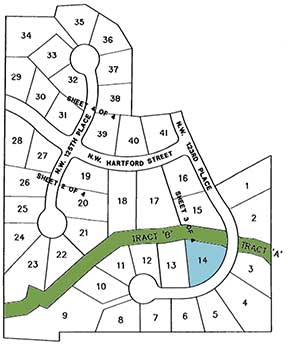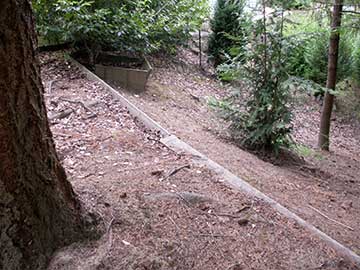 |
Previous Issues |
| Cedar Mill Community Website |
|
Search the Cedar Mill News: |
About The Cedar Mill News |
|
|||||||
| Volume 13, Issue 6 | June 2015 |
||||||
Who owns the creek?
|
||||||||
 |
| The Roznars' home is on the lot marked in blue. The stream is a named tributary of Willow Creek. |
She and the 16 neighbors who live along Tract A have had to deal with falling trees and disappearing yards. Some have built (possibly illegal) retaining walls at their own expense. The Roznars started trying to find out if the county, and/or Clean Water Services, could help her and her neighbors solve the problem. She contacted County Commissioner Greg Malinowski, who began asking questions of Land Use and Transportation managers.
The original plat for the property states, “Tracts ‘A’ and ‘B’ are riparian and drainage tracts. All benefits, rights, and duties of undivided and common ownership, including but not limited to the use and maintenance of all common areas designated in this plat and entitled Tracts ‘A’ and ‘B’ shall inure with abutting owners of the platted lots in this plat and are to be left in their natural state with reasonable maintenance.” Again, under normal circumstances, the entire HOA would share responsibility for maintenance, but lacking such a legal entity, it reverts back to the “abutting owners.”
Before long, county counsel got involved, stating, “the tract is in a significant natural resource area (Water Areas and Wetlands, Fish and Wildlife Habitat), so anything from tree removal (unless presenting an immediate danger to health or property) to bank stabilization would ultimately require a land use permit. In accordance with Section 422-3.3(5), bank stabilization in a significant natural resource area is a Type II use, and therefore would need to go through the Type II application process.”
 |
| Looking down from the streetside. Retaining wood and planters show the result of erosion. |
Clean Water Services Public Involvement Coordinator Sheri Wantland, says, “Neither the extent nor the cause of a problem has been established, and experts might come to different conclusions reflecting their point of view (geotechnical engineer, geomorphologist, etc.). Our advice was to ask a geotechnical engineer to take a look.” CWS has offered technical guidance on the vegetation and free native plants.
At this point, it seems that the county is telling the Roznars and their neighbors that they will have to hire lawyers and engineers, and proceed with a very expensive and time-consuming Type II development application if they have any hope of saving their back yards.
Washington County relies on HOAs to take responsibility for streamside maintenance, yet there is no formal relationship between these entities and the county, and no requirement that HOAs be established. Wantland notes, “without an active HOA, commonly owned tracts fall into disrepair. It’s difficult to engage multiple owners, especially when only a few live adjacent to the tract. Even those adjacent have differing viewpoints, priorities and resources, and it’s a challenge to launch a group effort after years of complacency. CWS has offered technical guidance on the vegetation and free native plants.”
Land use and watershed management, as they are practiced in Washington County, are still something of an experiment. So much of the growth over the last 20 years has been taking place on the foothills of the Tualatin range, with myriad streams that now have to carry significantly more water than their natural beds can handle. Planners are now being pressured by developers to decrease stream setbacks in North Bethany and other areas, to maximize buildable land. Water and gravity, however, still need to be taken into account.
![]()
Like us on Facebook for timely updates
Published monthly by Pioneer Marketing & Design
Publisher/Editor:Virginia Bruce
info@cedarmillnews.com
PO Box 91061
Portland, Oregon 97291
© 2013